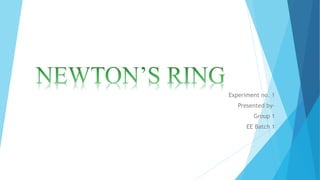Report
Share

More Related Content
What's hot (20)
Polarization of Light and its Application (healthkura.com)

Polarization of Light and its Application (healthkura.com)
Viewers also liked
Viewers also liked (20)
Similar to Newton's ring experiment
Similar to Newton's ring experiment (20)
Microscope part 2 BY DR. C. P. ARYA (B.Sc. B.D.S.; M.D.S.; P.M.S.; R.N.T.C.P.)

Microscope part 2 BY DR. C. P. ARYA (B.Sc. B.D.S.; M.D.S.; P.M.S.; R.N.T.C.P.)
Principles and application of fluorescence spectroscopy

Principles and application of fluorescence spectroscopy
Newton's ring experiment
- 1. Experiment no. 1 Presented by- Group 1 EE Batch 1
- 2. In this experiment, we have taken sodium lamp as the monochromatic source. By MONOCHROMATIC SOURCE, we mean a light source which emits particle of particular wavelength and not many wavelengths. Intensity of fringes also depend upon the air column between lens and the base.
- 3. These are INTERFERENCE fringes of equal thickness.
- 4. Some of the pictures of apparatus
- 5. Overall procedure of the experiment SOURCE- The source of light is MONOCHROMATIC light source. The rays of light reflects from the glass plate which is adjusted at 45 degree angle with the horizontal. After the reflection rays directly goes through plano convex lens. And when the light passes through the lens circular patterns are observed like rings , hence this experiment is named as Newton’s Ring experiment.
- 6. The microscope used in the experiment is travelling microscope i.e. it can be moved from left to right or vice-versa to observe the width of fringe, after which the formula of finding wavelength is applied. Microscope contains Vernier scale and Main scale. Both the reading are noted and applied in formula using LEAST COUNT of the scale.
- 7. Why the fringes observed are CIRCULAR in shape? Because the lens used in this experiment is Plano-convex lens.